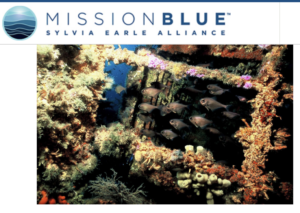Manmade Reefs for Fisheries: From the Sea of Galilee to Subway Cars in Delaware and Oil Rigs off the Texas Coast
Popular Science has a recent post about a 60,000 ton ancient rock structure discovered in the Sea of Galilee. The structure of stacked basalt rocks is some 70 meters by 10 meters:
The site itself rests near a now-defunct ancient outlet of the Jordan River, an area that has had economic importance in the area since the Bronze Age. Due to various contextual details, the researchers suspect that the cairn was constructed sometime between the 4th and 3rd centuries BCE.
Finding fish swimming around the structure, researchers guess it might have been constructed to attract fish:
These days, the cairn sits about 30 feet underwater, surrounded by schools of tilapia fish. Which brings us to the researcher’s theory that this cairn is supposed to be an ancient fishery, a structure that attracts fish, making it easier to catch them and support a large settlement along the shore. Smaller fisheries have been found in the Sea of Galilee, so this theory isn’t as far-fetched as one might think.
An earlier post discussed the use of old subway cars to create offshore reefs offering nifty condos for fish (“Build Your Own Reef“) .
“Saltwater Fishing” in The Sportsman’s Guide describes these artificial reefs off the coast of Delaware that attract both plentiful fish and fishermen. The largest of these reefs has 1.3 square miles of underwater reef fashioned from:
dozens of tanks and armored personnel carriers, a 90-foot sunken barge, a navy barge, and more than 400 old subway cars.
In this man-made underwater reef world:
schools of sea bass cruise from one subway car to another…sea bass also love to move in and around the open back of the armored personnel carriers. Big tog also hang out on the ocean reef sites…
 So maybe the local Flintstones were dropping their old cars in the Sea of Galilee in the fourth to third century BC to develop similar rich fisheries.
So maybe the local Flintstones were dropping their old cars in the Sea of Galilee in the fourth to third century BC to develop similar rich fisheries.
Lots of Feds in the Fisheries
The Federal government has involved itself with regulating and subsidizing artificial reefs as a way to promote fisheries. Fishing is big business, so the Department of Commerce and U.S. Fish and Wildlife Service (USFWS) are involved, along with NOAA. Not wanting to miss the boat, the Departments of Interior, Defense, Transportation, Homeland Security and Environmental Protection Agency also play a role, along with state fisheries agencies, with further regulatory supervision provided by the Corps of Engineers, Coast Guard, EPA again, NOAA, Minerals Management Service, and state and local government. Supplying coordination to the program and players is the Interstate Fishery Management Program of the Atlantic States Marine Fisheries Commission and the National Recreational Fisheries Resources Conservation Council. Yikes.
You can read about these organizations and the role they apparently play in dumping stuff in the ocean to promoting fishing, in this 2007 publication: “National Artificial Reef Plan (as Amended): Guidelines for Siting, Construction, Development, and Assessment of Artificial Reefs.“
The reef now supports more than 10,000 angler trips annually, up from fewer than 300 in 1997. And according to state data it has seen a 400-fold increase in the amount of marine food per square foot in the last seven years.
This has led to theft and sabotage of fishing traps and pots and the tangling of commercial pot fishermen’s lines with those of smaller hook-and-reel anglers. The rising tension has led the state to ask federal marine officials to declare the area off limits to large commercial fishermen. (Source.)
Why not privately funded and managed ocean reefs?
An alternative to federal tax-dollars sunk to create valuable reefs and fisheries that everyone then fights over, would be private investment for privately-owned and managed offshore reefs. People are willing to pay for the fun and food of fishing. And the process of paying can reduce the frustration, conflict and congestion caused by offering valuable resources too cheaply or for free. As with national parks, managers for these offshore underwater parks are having trouble discovering the right price to limit congestion and enhance enjoyment (plus earn profits to expand reefs and operations).
Michael De. Alessi explains in this Freeman article from 1997: “How Property Rights Can Spur Artificial Reefs Artificial Reefs Enhance the Marine Environment and Benefit Environmentalists and Recreationists.”
Texas Wants More Reefs
Not satisfied with vast amounts of onshore and offshore oil and gas, Texas wants more fish too. The Case For Saving Old Offshore Oil Rigs (Texas Monthly, 2012)
.
in a story about High Island 389-A, a thirty-year-old rig some 100 miles of the coast of Galveston, which is among 650 decommissioned drilling platforms slated for demolition.
“These structures attract marine life that normally wouldn’t use the area,” said Greg Stuntz, chairman of ocean and fisheries health at the Harte Research Institute for Gulf of Mexico Studies at Texas A&M University Corpus Christi. “Much is growing on them, from corals up to marine mammals.”
See also The new use for abandoned oil rigs (BBC, January 26, 2021):
For some species, offshore rigs are even better nurseries than natural reefs. The towering pylons are the perfect spawning grounds for tiny fish larvae
VIEWPOINTS: RIGS TO REEFS (MissionBlue, July 10, 2017):

Research scientists, divers, and fishermen visit reefed rigs. In the U.S., there are over 500 platforms reefed in the Gulf of Mexico . California is the only other state in the U.S. with a Rigs to Reefs law (AB 2503), however, none of the 27 offshore oil and gas platforms have been reefed. The distance of these platforms from shore varies widely. In the Gulf of Mexico there are platforms nearly 200 miles offshore near the Flower Garden Banks National Marine Sanctuary, and in California, there are platforms less than 3 miles from shore.
